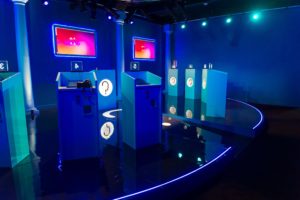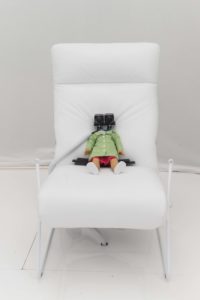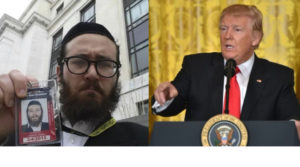
Entering the first room of the PACE gallery’s newest exhibit, “The Institute Presents: Neurosociety,” is like entering the set of a game show. Out of the dimly lit room looms an illuminated platform with 10 numbered podiums, each equipped with an iPad. Accordingly, the activity is also set up as a game show— participants are asked to choose a podium and are faced with several streams of yes or no questions about morality, each of which is to be answered within 3 seconds. The goal of the questions is to reveal how we respond to morally strenuous situations on first instinct, given no time to think through the choice or its possible consequences.
The questions approach topics such as the value of life, what makes an individual themself, and when (if ever) violence is justifiable. For example, are you still yourself if you lose part of your finger? What about your whole hand or whole body? What if you lose your memories? Where in your body exactly are you located? Should an individual be sacrificed to save a group? What if that individual is related to you? After each set of questions the average of the group’s response is displayed on the screen compared to the average of the 4,000 other visitors who have participated in the exhibit. The comparison is followed by an explanation of why people tend to respond the way they do, and the morality that is involved in each choice.
“The Institute Presents: Neurosociety” resembles a psychology-based Exploratorium for adults. Up to 10 participants are led through 4 rooms, each based off of a famous psychology experiment. Each room focuses on an element of the human subconscious. The series of activitiesaredesignedtobethought provoking, challenge our traditional ideas of the world and ourselves, as well as help us understand the human brain. The project, created by Mala Gaonkar, a technology investor, and David Byrne, a former member of the Talking Heads, is an attempt to enlighten people to the world of psychological experiments, and they have done so in partnership with “The Institute,” a consortium of several universities. The exhibit not only allows people to explore the world of modern psychology, but also assists in their ongoing research, as data is observed and collected anonymously on the participant’s reactions. However, the way the data is collected seems to be inconsistent due to the constantly changing nature of the exhibit, and therefore we are doubtful that the data collection can lead to accurately drawn conclusions.
After exiting the game show room, participants enter a room dimly lit by orange light. A partially obscured miniature scene is displayed behind a screen and participants are askedtomakeobservations.Thescene appears stationary until participants are next instructed to put on blue- colored glasses that, cancelling out the orange light, reveal the entirety of the diorama. Without the visual interference, it is revealed that the windmills, which had previously appeared stationary, are in fact moving, a trick of your brain. The purpose of the experiment is to reveal to participants that what they see may not always be what is really there. The optical illusion is surprising but perhaps not extremely thrilling.

The third room is designed to look like a classic high school classroom, with posters of presidents lining the walls. There are chalkboards and even a working PA system with the noises of children playing outside. Each participant sits at a desk equipped with an iPad, and is given 3 seconds to predict which of the two senators displayed on the projector beat the other and won each election. You must choose rapidly and based solely on their pictures—the game cycles through about 20 sets of senators. After the experiment, the group’s results are compared to the visitor average, and the true results of the elections are revealed. This room is a look into first impressions, how we judge people and candidates based on race, gender, smile, and overall attractiveness—how we are predisposed to label someone as “trustworthy” or not solely on a 3 second glance.
The last room is by far the most interesting. This room is bright white, and participants sit in a semicircle of white leather chairs. Once all are settled, the lights shut off and you are instructed to hold your hand in front of your face. A bright light is then suddenly flashed, and you are told to move your hand down and away from your face— phantom-like, an image of your hand stays floating in front of your face in the blackness, growing larger as your move your hand down. This experiment is then repeated while looking in a mirror; once again, you get the unworldly experience of watching your own face suspended in darkness, swelling, then floating away.

The lights come back on in the white room, and a curtain is pulled back to reveal a doll sitting in a chair; its head replaced with a camera. Participants are given a pair of virtual reality goggles, allowing them to see through the eyes of the doll. Looking down, it appears that the doll’s legs and body, with its green dress and plastic limbs, are your own—an extremely strange and confusing experience. When one of the tour leaders steps into the camera’s field of vision they appear to be a giant human towering above you. When a stick prods one of the doll’s legs a machine will prod each participant in the same spot, further cementing the belief that what they are seeing is, in fact, real. The tour leader will next open and close a pair of scissors while moving it towards the doll’s head, causing participants to cringe as they see the scissors approaching their own neck. They also perform other cringeworthy illusions with needles like giving you a shot or moving the needle horrifyingly close to your eyes.
Although the goal of the exhibit as a whole is to give participants a glance into the world of psychological experiments, there seem to be some elements that are missing. For example, the exhibit explores the concept of morality, but fails to include any information about morally controversial experiments that have been done in the name of psychological research—such as the very relevant Stanford Prison Experiment (conducted by former Stanford professor Philip Zimbardo). This may be a missed opportunity in educating the public on psychological research and its history. In addition, data on participants is supposedly being collected, but the experiments are not being done in controlled environments. The exhibit has been modified several times since its opening in October of 2016, mostly with changes in the order of the rooms. Additionally, within a week of our visit, the list of senate candidates shown in room 3 had been altered to eliminate all pictures of female candidates or candidates of color. These problems raise the question; what is the purpose of the exhibit and what are we really supposed to learn from it?
However, we found that the overall one hour experience is an intriguing look into neurological research and psychological phenomena, though at some points it seems to lack thorough explanations of how these phenomena work—why our brains perceive information in certain ways and what parts may be responsible for that behavior. At its best, the exhibit succeeded in forcing us to question our own ethics, as well as challenging our understanding of perspective and reality. Participants walk away with increased insight into their own minds, and hopefully greater perspective on their own perception and everyday choices. Some of the rooms were much more interesting than others, but the most exciting aspects of each have convinced us that similar exhibits would be beneficial and fascinating to experience in the future, especially as the virtual reality industry continues to grow.
by Solenn Grainger Monsen ’17 and Sutter Morris ’18






